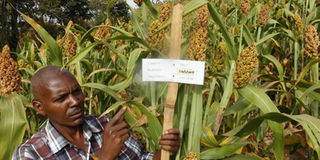Scientists release new hybrid sorghum variety

Francis Rukabanza, shows off fully grown MB27 at Kachwekano. Photo by Lominda Afedraru
What you need to know:
- Led by Dr Alex Barekye, the director at Kachwekano Zonal Agriculture Research Institute, researchers say the new sorghum hybrid will help boost household incomes because it is high yielding, writes Robert Muhereza.
Kachwekano Zonal Agriculture Research Institute in Kabale district has uncovered four new high yielding varieties of sorghum.
Gard Turyamureeba, the research scientist in charge of breeding at Kachwekano Zonal Agriculture Research, revealed as MB27, BM29, E1291 and Ndamoga the four hybrids which will be availed to farmers later this year.
Turyamureeba says these new varieties which are disease and drought resistant will replace the much weakened varieties of Kyatanombe, Magune, Kabusiba and Ruyanga. “MB27, BM29, E1291 and Ndamoga are the latest high yielding hybrids which we strongly believe will address the problems of low crop yield, diseases and declining in soil fertility,” said Turyamureeba.
“Once these varieties are approved of by the Ministry of Agriculture Animal Industry and Fisheries; the farmers will be able to purchase them ahead of the new season.”
Dr Alex Barekye, the director at Kachwekano Zonal Agriculture Research Institute, further explains that the four new varieties yield more than five times the old varieties.
“The yield capacity of the new variety is 5,000 kilogrammes (five tonnes) per acre compared to the old varieties which have been giving farmers just 500kilogrammes from the same acreage,” said Dr Barekye. “The varieties will not only give farmers better yields, but they are also vital for smallholder farmers and communities especially those in Kabale who rely on this crop for food,” he added.
Maturity
According to Dr Barekye, the hybrids have a maturity period of 130 -140 days.
“Mature crops measure about three metres compared to the old variety which measure above five metres on maturity,” said Dr Barekye who reveals that the researchers at Kachwekano worked closely with National Agricultural Research Organisation (Naro) to develop the variety.
Soil testing
Use soil sampling techniques to gauge fertility and maintain optimum soil nutrient levels. Restore more nutrients to the soil than were removed during harvest of the previous crop. For example, pre-plant fertilisers may enhance weed control and encourage greater plant growth sooner.
PLANNING
Best management practices go a long way to help farmers secure the best yields and return on investment when planting grain sorghum. While there are many factors involved in achieving top yields, the following top tips can help add bushels and profits to produce the best grain sorghum outcomes:
Hybrid selection
Choose the best sorghum seed hybrids for regional and individual farming practices and that offer the highest yield potential in their maturity group (early, medium or late maturing). Select grain sorghum hybrids that have some tolerance to sugarcane aphids.
Seed treatments
Purchase seed professionally treated with a quality combination of fungicides and insecticide to support sorghum stand establishment and get seedlings off to a vigorous start. A seed treatment is a cost-effective risk management tool to protect crops from yield-robbing diseases and pests early in the season and may provide up to 40 days of early season protection against sugarcane aphids.




